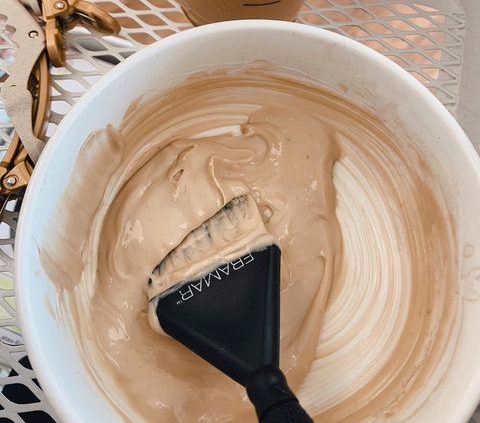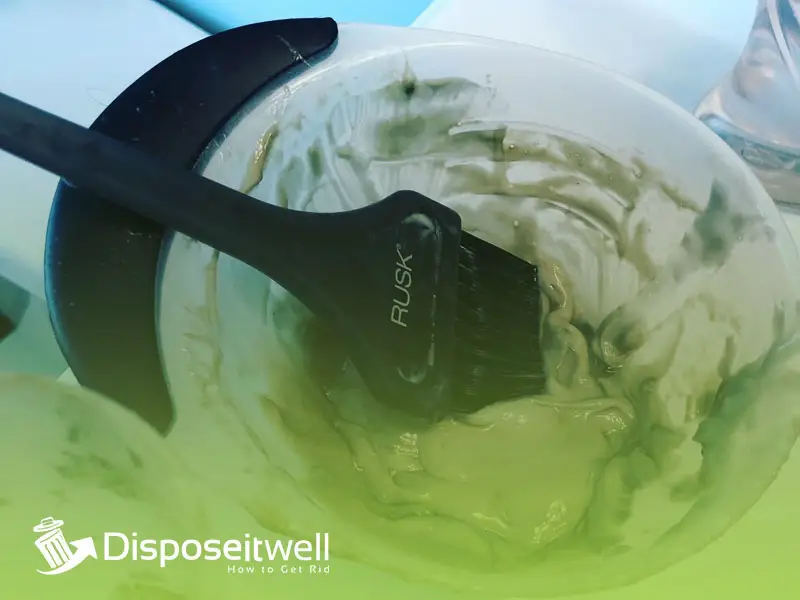If you have ever dyed your hair at home, chances are you have ended up with some leftover hair bleach. But what to do with it? you may be tempted to just pour it down the drain, but that can be bad for the environment.
Can you save it for the next time? How long does the blech last?
Well, Wonder no more! We will answer all of your questions about leftover hair bleach, so you can make the most of your money.
We have rounded up some of the best ways to use leftover hair bleach, from giving yourself a quick touch-up to cleaning your bathroom, these ideas are sure to come in handy.
So, the next time you find yourself with a little bit of bleach left over, don’t pour it down the drain. Put it to good use with one of these clever ideas.
What To Do With Leftover Hair Bleach?
Not sure how to utilize the leftover hair bleach? Given below are some options that may work for you:
1. Use It as a disinfectant: Bleach is a great disinfectant and can be used to clean surfaces around your home.
2. Unclog Your Drain: Did you know that hair bleach can also unclog drains? Simply pour it down the drain and let it sit for 15 minutes before flushing it with hot water.
3. Make DIY Disinfectant Wipes: If you have some old rags lying around, put them to good use by cutting them into small squares, and soaking them in a bleach solution. You’ve got your very own DIY disinfectant wipes.
4. Remove Stains: Stain something? To get rid of a stain, simply pour some bleach on it and watch it disappear.
5. Clean Your Toilet: Got a dirty toilet? Pour 1/2 cup of bleach into the bowl and let it sit for 30 minutes before flushing for a sparkling-clean toilet bowl.
6. Refresh White Laundry: Tired of your white laundry looking dull? Bleach them! Just add 1/4 cup of bleach to the wash cycle next time you do your whites and they’ll come out looking brand new again.
7. Whiten Your Grout: Mix equal parts bleach and water and apply it to your grout with an old toothbrush. Allow the product to sit for 10 minutes before removing it with a cloth for whiter grout lines.
8. Sanitize Your Cutting Board: It’s important to keep your cutting board bacteria-free, and what better way to do that than with bleach? Simply mix 1 tablespoon of bleach with 1 gallon of water and soak your cutting board for 2 minutes before rinsing thoroughly with hot water.
9. Get Rid of Mold & Mildew: Mix 1 cup of bleach with 1 gallon of water in a spray bottle and use it to remove mold & mildew from surfaces around your home like tile showers, bathtubs, or sinks.
10. Kill Weeds Naturally: Don’t want to use harmful chemicals on your lawn? No problem! Mix 1 part bleach with 9 parts water in a spray bottle and spray on weeds like dandelions or clover for a natural weed killer that won’t hurt your grass.
How To Dispose Of Hair Dye?
Here are some ways to get clear out hair dye:

Dangerous Elements:
Never dispose of hair dye in the garbage or compost bin, similar to how you would never throw away hair bleach. This product contains harmful chemicals that could be hazardous to the environment, animals, and humans. To ensure the safety of you and your family, you must dispose of any hazardous chemicals properly. Start by familiarizing yourself with the local area rules on chemical disposal.
Either Donate Or Share It:
The safest way to get rid of hair dye is by sharing or donating it. This way, you can rest assured the chemicals won’t damage the environment. Talk to your friends or relatives and see if they would like to utilize the hair color before it expires. Alternatively, you can donate your leftover hair dye to a beauty school or local salon.
Disposing Of The Hair Dye Container:
Dispose of the dye properly, then check to see if the container is recyclable. If the container doesn’t have any recycling information, check with your local recycling depot to see if they accept containers that hold bleach or dyes.
For How Long Hair Bleach Is Good?
Knowing how to correctly dispose of your leftover hair bleach is not the only important aspect. Additionally, remember that this chemical product expires eventually if left open. With this knowledge, you will be able to discern how harmful this item can be at certain points, as well as if it is safe to utilize leftover units from a previous session.
Although hair bleaches don’t expire for almost two years, double-check the expiration date on the box before using it! Inhaling the vapors from expired hair bleach can damage your hair and negatively affect your health.
In addition, if the product expires, it may not work as intended (but this is a small price to pay in comparison to the damage that could be done to your hair). Keep in mind that when bleaching your hair, the chemicals will quickly degrade and become less effective when exposed to sunlight. Within 20 minutes, the product begins to lose its luster!
Because some hair dyes or bleaches contain bleach powder, developer, or other chemicals, the product’s shelf life may be shorter than average. It can be difficult to find an accurate shelf life due to discrepancies in manufacturer claims.
Before using hair bleach, make sure to check the expiration date on the packaging. If it is expired, follow the instructions above for disposing of it rather than using it. In the long run, it is cheaper and easier to buy a new one than deal with damaged hair.
Can We Drain Down The Hair Bleach?
Pouring hair bleach down the drain is safe as long as you dilute it with water and don’t mix it with other chemicals.
Otherwise, it will have the following bad impacts:
- Can damage septic systems.
- Corrodes pipes, leading to expensive repairs for homeowners.
- Can react with other substances in the sewer system and create harmful compounds.
- Also harms aquatic life.
If you’re worried about the environment, it’s best to reach out to your regional hazardous waste management company and ask how you can get rid of your extra bleach securely.
What Is The Natural Way To Deal With Hair Bleach?
The best way to deal with hair bleach naturally is mentioned below:
– Use a deep conditioning treatment at least once a week to help repair and nourish damaged hair.
– Heat styling tools are a big no-no. Instead, let your hair air dry whenever you can.
– A leave-in conditioner or anti-frizz serum can aid in making hair more manageable and less frizzy.
– Massage your scalp with oils, such as argan or coconut oil, to nourish and promote healthy hair growth.
– Consult a professional stylist for any further damage control or color correction options.
Furthermore, only bleach your hair sparsely and with the recommended precautions, as too much bleaching can lead to permanent damage. Take care of your hair to prevent future problems.
How to Use Hair Dyes Safely?
Using hair dye is a great way to switch up your look, but you must do so safely to prevent any possible health issues.
If you follow these steps, you will be able to dye your hair successfully and without any mishaps:
– Always do a patch test 24 hours before applying the dye to make sure you aren’t allergic or sensitive to any of the ingredients.
– Take the time to read and follow the instructions on your chosen dye’s packaging.
– By wearing gloves, you are creating a barrier between your skin and any possible irritants or stains.
– Use old towels or clothes to protect your surroundings from possible spills.
– Unless you want to damage your hair, don’t leave the dye in for more time than recommended.
– Rinse the dye thoroughly and use a deep conditioning treatment afterward to keep your hair healthy and nourished.
By taking these precautions, you can confidently and safely experiment with different hair colors. Have fun with your new look!
FAQs
What is hair bleach made of?
The main active ingredient in hair bleach is usually hydrogen peroxide, which breaks down the pigments that give hair its color. Other common ingredients include ammonia to open the hair cuticles and sodium persulfate as a bleaching agent.
Is hair bleach toxic?
A. Although hair bleach is not technically toxic, it does contain harmful chemicals. The toxic chemicals in hair bleach are hydrogen peroxide and ammonia. Dumping these compounds in the trash can seriously harms the environment.
Is hair bleach PPD free?
Yes, it is possible to find hair bleach that is free of the harmful chemical PPD. More and more brands are now offering PPD-free options to ditch hair bleach in a safe and eco-friendly way. PPD-free products are safe because they don’t contain para-phenylenediamine, a harmful chemical.
Is hair bleach age restricted?
You don’t have to be a certain age to buy hair bleach. It’s important to make use of this item safely and correctly. If you want to avoid damaging your hair, it is best to go to a professional when using bleach.
Is hair bleach and face bleach the same?
No, hair bleach and face bleach are two different things. Hair bleach is used to lighten the color of hair, while face bleach is used to lighten dark spots or uneven skin tone on the face. It is important to use the correct product for each purpose, as using hair bleach on the face can lead to irritation and damage to your skin.
Conclusion
Bleaching your hair at home can be dangerous to both yourself and the environment if you don’t take the necessary precautions. Because bleach is corrosive and hazardous, you must follow the right steps to get rid of it. Peroxide-based hair bleach is harsh and can cause damage to both hair and scalp if not used correctly.
Carefully following the bleach kit instructions is key to achieving your desired hair color, and leaving bleach in your hair for too long can lead to damage.
We hope you have learned a lot from this article on how to handle leftover hair bleach and other things related to it!
Happy bleaching!
My name is Ella Vicedomine and I’m the founder of this blog. The aim is to start this informational blog to guide people on how to dispose of waste things around in the house but in the right way.

